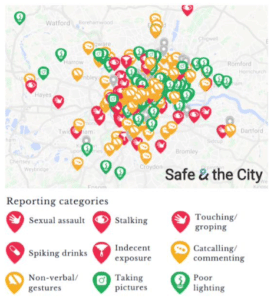Report: Impact of Smart Cities, Startups and Co-Working on Gender Equality 3/4
Antonia Terriuolo, with Margherita Girotto, Anastasiia Chaikovska wrote an excellent report on how smart cities, startups and co-working contribute to gender equality at Ca’Foscari University of Venice. Access the first part here and the second part here.
Continue to read below, for the third part of the report.
6. Innovation and SDGs
Having stated previously that Safe & The City can be viewed as an example of the action implementation towards the innovative process that is Smart Cities, it may be said that the company has a strong position in the context of the UN SDGs. They state that Safe & The City contributes to Gender Equality, Reduced Inequality, and Sustainable Cities and Communities. Moreover, the global indicator framework for SDGs was developed by the Inter-Agency and Expert Group on SDG Indicators (IAEG-SDGs) and agreed upon at the 48th session of the United Nations Statistical Commission held in March 2017 (United Nations, nd).
For the following subchapters, Smart & the City will be viewed as an equivalent and adequate solution for Smart Cities.
6.1. Gains and Impacts Concerning SDG Number 5
Given the report developed by Safe & The City in partnership with the UN Women in the United Kingdom, it is possible to gather relevant data in terms of the scope of this body of work.The report focuses on sexual harassment, as it is considered the most frequent form of violence that women are experiencing within the EU. Regarding this, 64% of women of all ages and 85% of women aged 16-24, in the UK, have experienced sexual harassment in public spaces; while, not less significantly, 38% have experienced a form of verbal harassment between the ages of 14 and 21. Since these experiences are affecting choices, behaviors and, overall, have a huge impact on women’s lives, the UN Women’s global program Safe Cities & Safe Public Spaces, developed in 2012, is the first-ever global program that brings together women’s organizations, local and national governments, UN agencies, and other partners to develop, implement, and evaluate tools, policies, and comprehensive approaches, for prevention of and response to sexual harassment and other forms of violence against women and girls across different parts of the world. This project aims to highlight these relevant aspects in the eyes of private and public institutions, to give voice to, otherwise, unreported incidents, fueling investments and concrete actions to be taken. The analysis of the data collection work based on the London area led to the successful acquisition of 394 anonymous individual reports, considering these different variables: category of the incident, time of the incident, location of the incident, and qualitative free-form text. More specifically, the analysis showed that most of the reported incidents are unsettling comments, catcalling, touching, and groping mostly during rush hour in crowded settings. the incident
The categories of each incident are made shown in the legend below, where the London map shows the incidences on a geographical scale (Fig. 6).
Fig. 6: Greater London Incident Reports Taken From Study Period (UN Women United Kingdom, nd, p. 2).
Additionally, UN Women UK has implemented a project called Safe Spaces Now bringing together shareholders from different sectors accelerating the progress towards safety in public spaces in the UK. Moreover, it is built to generate a growing data picture of the reality of women’s safety, going over the issues in designing adequate solutions, through partnerships with public space owners, and finally scaling the process to create a lasting and official change process (UN Women UK, nd).
Therefore, given the scope of this body of work, Safe & the City helps in terms of making traveling within a certain area safer for women as a marginalized group and thus helps move the respective cities towards becoming a Smart City.
6.2. Adequate Indicators to Assess SDG Number 5
Given the scope of the SDGs the following targets concerning SDG number 5 are especially of relevance in terms of Safe & the City:
- Target 2: “end all violence against and exploitation of women and girls”;
- Target 8: “promote empowerment of women through technology”;
- Target 9: “adopt and strengthen policies and enforceable legislation for gender equality” (Ritchie, Roser, Mispy & Ortiz-Ospina, 2018).
Considering Safe & The City innovation the following additional indicators might be relevant:
- income;
- Sex;
- ages;
- race;
- ethnicity;
- migratory status;
- disabilities;
- Method of transportation; other
- Geographic location.
Given the fact that Smart Cities encompass the personal sphere of every citizen, the personal characteristics of minority groups should be used as an indicator towards the progress of SDG 5 as well. As previously explained, women’s travel needs differ greatly from their male counterparts, meaning that “Method of transportation”, as well as “Geographical location” (rural or urban area) should be focused on, where Safe & the City provides the first initiative into that direction.
6.3. Impacts on Socio-Economic Factors
Given the globalized world we live in today, the economy all over the world has seen specific changes, that are unrelated to the specificity of locality but have different impacts in different areas around the world. In other words, a developed country that fails to keep up with the fast-moving technology innovations will fall behind quicker than a developing country, as it has never caught up with the developed world, to begin with.
The specific changes mentioned may be “growth of […] information-rich economy and society, […] and continuing growth of digital technologies” (Anttiroiko, Valkama & Bailey, 2014, p. 323) among others. Those changes affect how the city organizes itself, thus affecting city governments. In this respect, the concept of Smart Cities can open new areas of opportunity to the development of a city, which are characterized as “cities with smooth information processes, facilitation of creativity and innovativeness, and smart and sustainable solutions promoted through service platforms” ( Anttiroiko, Valkama & Bailey, 2014, p.323). Since the wish to become a Smart City is driven by the international competitiveness driving our economy, through the implementation of Smart City initiatives, local areas provide new space for business and clusters to emerge (Bakici, Almirall & Wareham, 2013). Consequently, providing the local economy with areas of increased productivity and new jobs to take and consequently, creating new/additional competitively in the market. Therefore, Smart Cities can act as developers of the local economy and local workforce.
However, experience has shown that the Smart City concept is often too broad, providing a one-size-fits-all solution when in reality the specificities of the locality are very important in determining what is needed and possible in terms of the creation of a smart city Moreover, since the concept is relatively new, in-depth research and case studies are still missing (Kitchin, 2014), which are paramount to provide a more realistic view of the concept. Generally, the impact on socio-economic factors like productivity, competitiveness, and employment could be immense considering the theoretical application of the Smart City concept. Therefore, constant revision and adaptation of the strategy are needed to overcome the lack of empirical evidence and fill this hole in the literature.
Part 3 of 4. We hope you enjoyed reading and are looking forward to the next part!

